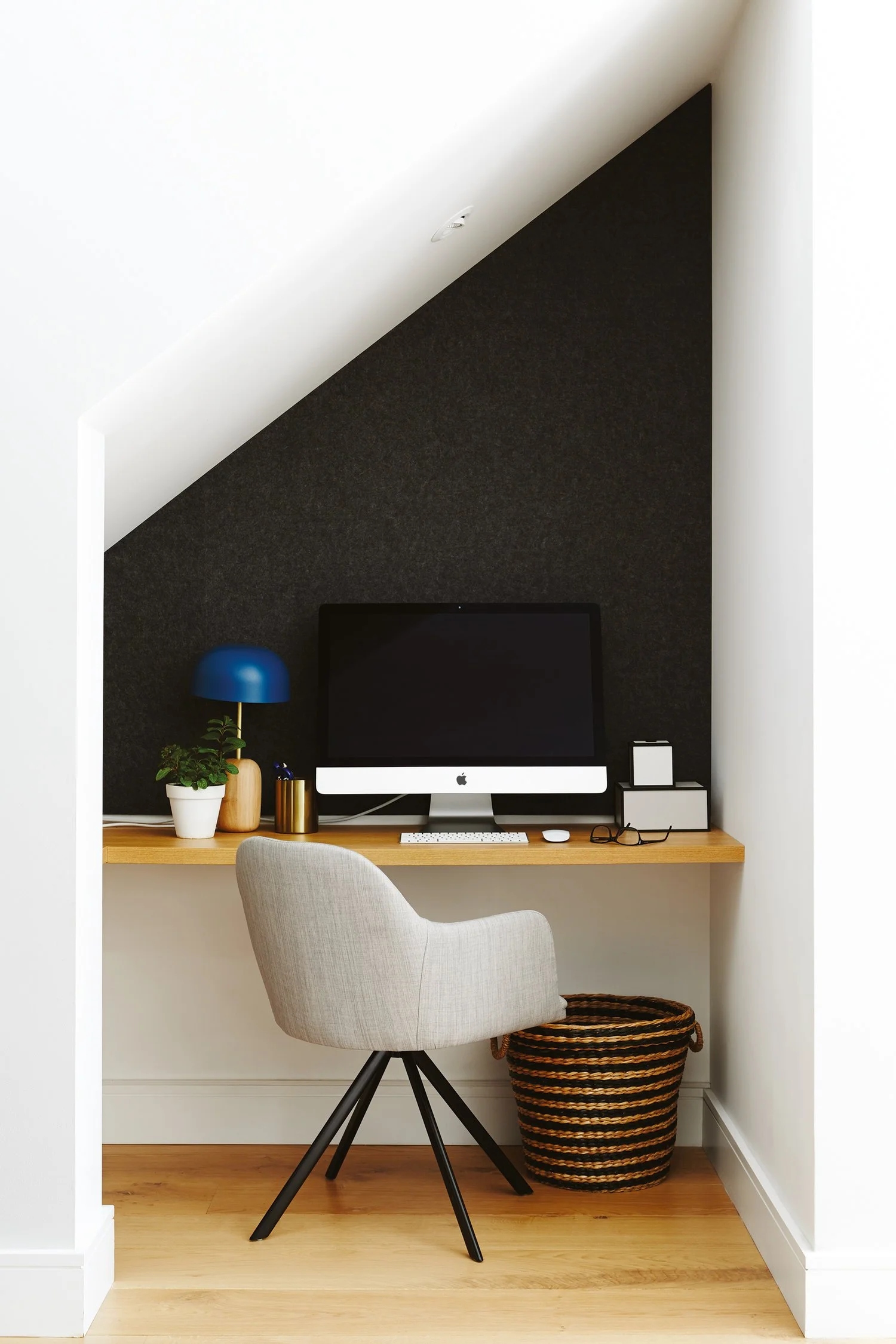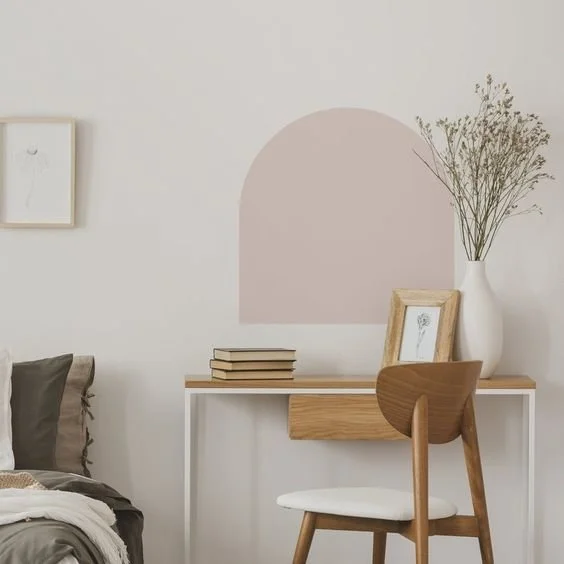Homework.
Whether you have an existing home office space to work from, or just the kitchen table, we’re here to help conceive an efficient working space for you. No matter the physical scale, our key takeaway will always be that organisation is essential to the success of any workplace, and can help you to manage stress and anxiety and keep you productive. Here are our tips to get your home office working just as hard as you are…
1. Location/ Position
2. Furniture + Wellbeing
3. Lighting
4. Small Transformations
5. Large Transformations
If you’re working with computers or screens make sure you allow for the angles of light through the day to avoid glare.
Think carefully about the window treatment- can you control the amount of light entering the room? Have you got enough privacy? Shutters or a thin light blind are the best options.
1. LOCATION/ POSITION
In an ideal world you already have a dedicated office space, or at least spare room that you can close the door on when you finish your shift. But for most of us it will be a decision about where we can afford to ‘spare’ some space.
The nature of your work, and working style, may vary but for most of us working at a designated table or desk is the norm. If you can, orient the space towards the windows, the gentle natural light and movement will aid productivity. If you have to face an unstimulating wall, try positioning a mirror above your desk and this will bounce the light with reflections off your nearest window.
If possible, find a quiet space away from people and distractions like the TV (or the kitchen, when you feel snacky). Make a point of not being close to your daily chores. Make sure your room is warm and comfortable and ideally be able to shut the door.
Vanessa: “ For me, we could spare the most space in my son’s bedroom, but it just wasn’t going to work to ask the children not to access their play area when I needed to work. I also work into the evenings long after he’s gone to bed.
The compromise was to adapt a console table in our bedroom, we sourced a glass top that was slightly larger to accommodate our computer and allow me to take notes, sit a little plant and a coaster for a hot drink. I re-located a slim standing lamp from downstairs so it wouldn’t occupy even more space on an already slim table. I keep a basket next to me where I can file my bits away to keep the desk clear (especially from tiny hands) but also keeps it available for my husband to work from. It is important for us to set limits between work and sleep!”
It’s about being creative with what you have – hallways, landings or small nook under the stairs? Yes, they’re awkward but there are ways to style them, so they don’t encroach too much on your lifestyle and you can maintain the work/life boundaries.
Image from Adore Magazine October 24, 2017
Photography: Annette O'Brien
2. FURNITURE + WELLBEING
Questions to consider: Does your space need to transform back to anything else after the work shift to accommodate another activity? What is your allocated office space footprint? If small, consider scale of furniture so as to not overpower the space. If you don’t need a large workspace, consider a console desk for your laptop that can continue its life as a dressing table in the future.
If you haven’t already, your employer might be happy to lend you your desk and chair to use at home, or possibly look to support an investment for you doing so.
Rule Number 1- Make sure it fits! Make sure your new piece will move easily through tight spots before placing your order. Measure, and even mask tape the dimensions of your furniture and 1m of space behind the seat. Ensure clearance under desk space.
I personally prefer open desks without front panels, as they’re not visually heavy. Some come with open shelving on the side (added storage keep things off your workspace) allow to stretch your feet or open for a meeting. Corner desks allow you to split your workstation into two, and if you like to be more mobile you can look at standing desks too- you can purchase a ‘riser’ so that you can alternate between both. Whatever you decide, be careful with wire management. Some desks already come with tidy wire channels, consider placing your desk for the safest way to run cables to a power point. It sounds drastic, but you might even need to look into trunking, especially if you have little ones at home.
Clear glass desks are ideal for small spaces as the glass top makes it practically invisible, blending into the background of your home and allows light to easily flow through a space so your flat doesn’t look any smaller.
If your space allows, consider bespoke purpose-built office desk and shelving to maximise and transform your space. You can design it so that everything has its own home, and you won’t have to look at any distracting clutter. All your tech needs can be designed into the scheme and hidden/ or within easy reach as required. Although more expensive than off-the-shelf options, custom furniture is worth the investment if you use the space every day. It can also be the best option for a multifunctional space, such as a guest room.
SEAT, get one that is comfortable for long days but can still be easy on the eyes. If you’re not sat for most of the day, opt for a stylish but functional in-between office chairs that look like a ‘feature’ chair that won’t eat up all your space. There are so many options now adays with an upholstered seat and back but with a swivel. Some of our favourites are from West Elm. They are supportive, don’t take up loads of room with bulky arms and huge headrests. However, investing in an ergonomic chair that you can adjust to support you, your back & shoulders will probably thank you for it. Worst case scenario you can re-upholster or simply place a throw over it.
3. LIGHT
Apart from ambient lighting your task light is essential. Preferably you would choose a light with dimming features so you can regulate it at different times of the day and for different purposes. Light with a fabric shade will diffuse the light evenly throughout the space and make it easier on your eyes. A rotating lamp base/ shade helps facilitate positioning the light where you need it.
4. LOOK AND FEEL
Surround yourself with foliage! Plants connect us with nature and normally help calm us. They’re colourful and can be low maintenance. Budget friendly option is to cut a stem or foliage from a walk in your day and add it to a glass of water on your desk! Large scale plants and rugs can also help to ‘zone’ a working area and help with noise reduction.
Artwork surround yourself with things that bring you joy and keep you motivated.
Scented candle This is super simple but creating a calm and pleasant atmosphere is key to making you feel comfortable in your surroundings.
DECORATING
Another way of designating your workspace is by adding paint to an existing architectural feature to make it stand out, or alternatively an interesting shape of paint to a space lacking in detail! This technique can be used behind a bookshelf, to zone a desk area, cabinetry for a unique piece of furniture. This trick can be playful but effective to draw your eye and focus on something and give it a new lease of life.
If a pattern is more your thing but wallpaper is not an affordable option, painting vertical stripes can add instant height to a room, while horizontal stripes make a room look wider. Whilst we’re on the subject, COLOUR is super important too, if you’re committed to decorating consider how your colour makes you feel (does it calm you/ energise you?). Try living with the sample swatch near you first…
There is no One Size Fits All for your workspace but there are small improvements we can tweak to help improve and facilitate our working day.
Wire management…chargers/ wireless if affordable (and neater)
Lumbar support
Height adjustable desk (standing riser)
Desk Storage (Pens, post-its, stationary)
Lamp
Natural light
Plant
Noise reducing headphones- what are the acoustics like?
LETS BUILD! If budget allows consider investing in your home and making better use of your space to suit your needs. You could build a garden office for ultimate privacy (you should be able to construct it under permitted development if within certain dimensions). Create a home office by extending, this can be into your loft or outwards. Even more easily you could convert an existing Garage.
Which ever route you decide, start by drawing a scaled floor plan of your home office on squared paper and plot where the important furniture, like your desk, reading chair or workstation will sit. Make sure these points have enough plug sockets to service everything that you need to work with.
Good lighting is also known to improve productivity, so make sure your new office is well lit. In work areas, incorporate task lighting to light the space directly. Having a series of spotlights in the roof will ensure that the space is properly lit. If you’re going for a more relaxed work space, use a combination of table and floor lamps. Extensions tend to be cooler than the rest of the house, so investing in underfloor heating might also be a viable solution to keep the area warm without installing radiators, which can encroach on space.
Better yet, get in touch with us and see if we can help you get started!




